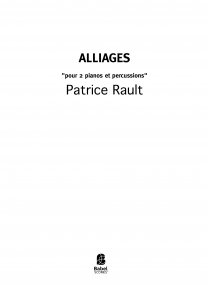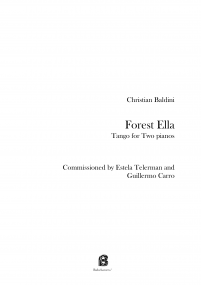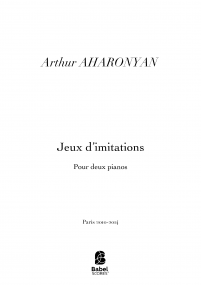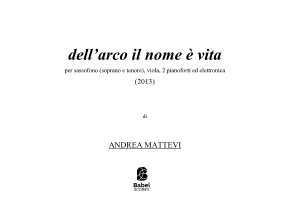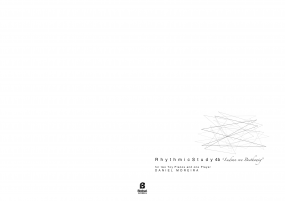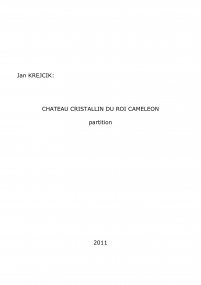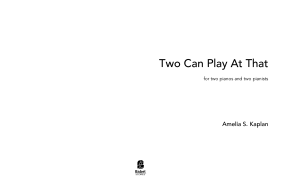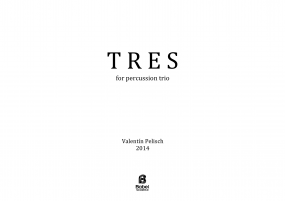Goethe's Garden
for two pianos tuned a quarter-tone apart
14,42 €
Digital version (+0,00 €) instant download
Printed format (+21,40 € printing and shipping). Colissimo7-14 days aprox.
When you buy a score, you can contact the composer right here!
Specifications
Region
North America (Canada - USA)
Estimated Duration
31 - 40min
Date
2017
ISMN : 979-0-2325-4616-2
Videos on this piece
Notes on this piece Goethe’s Garden is based on the tree figure or pattern (Xenakis calls it arborescence), both metaphorically and structurally. This idea of the world tree, a tree as a root or the original source of universal energy, appears in numerous mythologies and religions throughout the world. Examples include the Tree of Life in the Garden of Eden, Yggdrasil in Norse mythology, the Bodhi tree of Buddhism, the Seonangdang(성황당) of Korean shamanism, and so on.
It is no coincidence that I found Goethe’s writing about trees, The Metamorphosis of Plants (Die Metamorphose der Pflanzen), while reading Webern’s book, The Path to the New Music. Here Webern introduces the idea of the tree to evoke the concept of musical unity. Although the image of the World Tree per se doesn’t appear in Goethe’s book, he does indeed mention the idea of a primordial tree in a series of letters to Charlotte von Stein. It is a metaphysical prototype-tree, in which all the essence of trees is immanent, which he calls “Die Urpflanze.”
In my piece I have rendered the image of this primordial tree as the overtone series: not as a simple ascending integer series, but rather as a 2nd dimensional tree-type data structure: each of its inner nodes has its own overtone sub-branches (this idea of using tree type data structure emerged while I was reading an interview with the composer Philippe Leroux, in which he explained the idea but didn’t actually realize it in his compositions, and Ben Johnston’s writings as well).
This structural foundation of musical materials led me to try to portray trees “graphically” as well. The visual representation of sonic entities (or vice versa) has a long history, from the Geiger counter (developed in 1928), to Debussy’s geotropic signature melodic contours and musical paintings of clouds (Nuages) and the sea (La Mer), to Takemitsu’s gardenic geological orchestrations (Arc) or his more intimate composition, Rain Tree Sketch. Other examples include Xenakis’s arborescent figures in many of his works, including Evryali, along with the digital waveforms of Grisey’s Vortex Temporum, or recently the sonic alphabets of Leroux’s Vox Rei, and acoustical genes of Stephen Taylor’s Writhe series.
To render the infinite variations of tree forms and physiognomies, I adopted Barnsley’s Fern model, which uses a transformation matrix with probability variables, in a mathematical formula of self-similarity: Iterated Function System (IFS.)
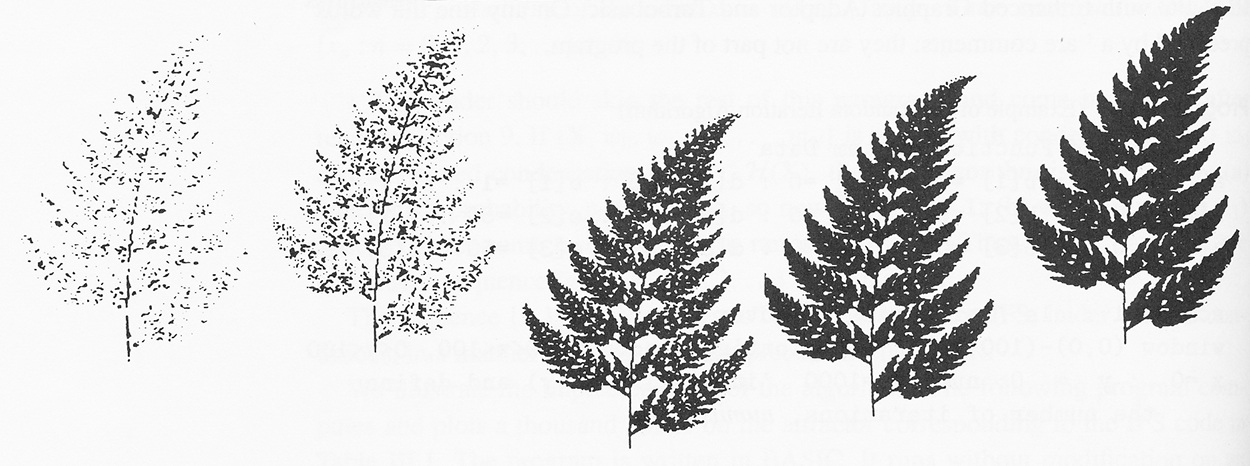
Michael F. Barnsley, Fractals Everywhere, new edition ed. (New York: Dover Publications, 2012), 90.
What the audience will actually hear is possible with two pianos, each tuned a quarter-tone apart: an infinite, quasi-overtone series, with thousands of variations and ramifications with different interval orders, rigorously coherent because of a limited number of core, just intervals. Certainly this idea has a strong connection with Lutoslawski’s harmonic language. While he uses only limited intervallic content, he is able to create a myriad of harmonic tableaux in 12-tone harmonic fields by rearranging his intervals in different registers and timbres. Here I have developed these intervals by combining a recursive fractal algorithm with just intonation. The result, I hope, is a palette of diverse harmonic and timbral colors with idiosyncratic intervallic characters, created by repeating, ever-changing probability transformation operations. The harmonies, with their microtonal deviations or distortions, are engendered by just intervals of prime number ratios. But just like a tree in the forest, Goethe’s Garden is a single, unified entity: every tree is an overtone simulacrum (self-similarity), with randomness and variability, of the ur-Pflanze.
Add to a playlist
- Login to create your own lists
It is no coincidence that I found Goethe’s writing about trees, The Metamorphosis of Plants (Die Metamorphose der Pflanzen), while reading Webern’s book, The Path to the New Music. Here Webern introduces the idea of the tree to evoke the concept of musical unity. Although the image of the World Tree per se doesn’t appear in Goethe’s book, he does indeed mention the idea of a primordial tree in a series of letters to Charlotte von Stein. It is a metaphysical prototype-tree, in which all the essence of trees is immanent, which he calls “Die Urpflanze.”
In my piece I have rendered the image of this primordial tree as the overtone series: not as a simple ascending integer series, but rather as a 2nd dimensional tree-type data structure: each of its inner nodes has its own overtone sub-branches (this idea of using tree type data structure emerged while I was reading an interview with the composer Philippe Leroux, in which he explained the idea but didn’t actually realize it in his compositions, and Ben Johnston’s writings as well).
This structural foundation of musical materials led me to try to portray trees “graphically” as well. The visual representation of sonic entities (or vice versa) has a long history, from the Geiger counter (developed in 1928), to Debussy’s geotropic signature melodic contours and musical paintings of clouds (Nuages) and the sea (La Mer), to Takemitsu’s gardenic geological orchestrations (Arc) or his more intimate composition, Rain Tree Sketch. Other examples include Xenakis’s arborescent figures in many of his works, including Evryali, along with the digital waveforms of Grisey’s Vortex Temporum, or recently the sonic alphabets of Leroux’s Vox Rei, and acoustical genes of Stephen Taylor’s Writhe series.
To render the infinite variations of tree forms and physiognomies, I adopted Barnsley’s Fern model, which uses a transformation matrix with probability variables, in a mathematical formula of self-similarity: Iterated Function System (IFS.)

Michael F. Barnsley, Fractals Everywhere, new edition ed. (New York: Dover Publications, 2012), 90.
What the audience will actually hear is possible with two pianos, each tuned a quarter-tone apart: an infinite, quasi-overtone series, with thousands of variations and ramifications with different interval orders, rigorously coherent because of a limited number of core, just intervals. Certainly this idea has a strong connection with Lutoslawski’s harmonic language. While he uses only limited intervallic content, he is able to create a myriad of harmonic tableaux in 12-tone harmonic fields by rearranging his intervals in different registers and timbres. Here I have developed these intervals by combining a recursive fractal algorithm with just intonation. The result, I hope, is a palette of diverse harmonic and timbral colors with idiosyncratic intervallic characters, created by repeating, ever-changing probability transformation operations. The harmonies, with their microtonal deviations or distortions, are engendered by just intervals of prime number ratios. But just like a tree in the forest, Goethe’s Garden is a single, unified entity: every tree is an overtone simulacrum (self-similarity), with randomness and variability, of the ur-Pflanze.
Instrumentation
Piano (2)
Recording
V. gleichsam auf einer geistigen Leiter - as on a spiritual ladder
18th Annual 21st Century Piano Competition Concert
18th Annual 21st Century Piano Competition Concert
Score Details
Format - Undefined
Pages - 90
Pages - 90





